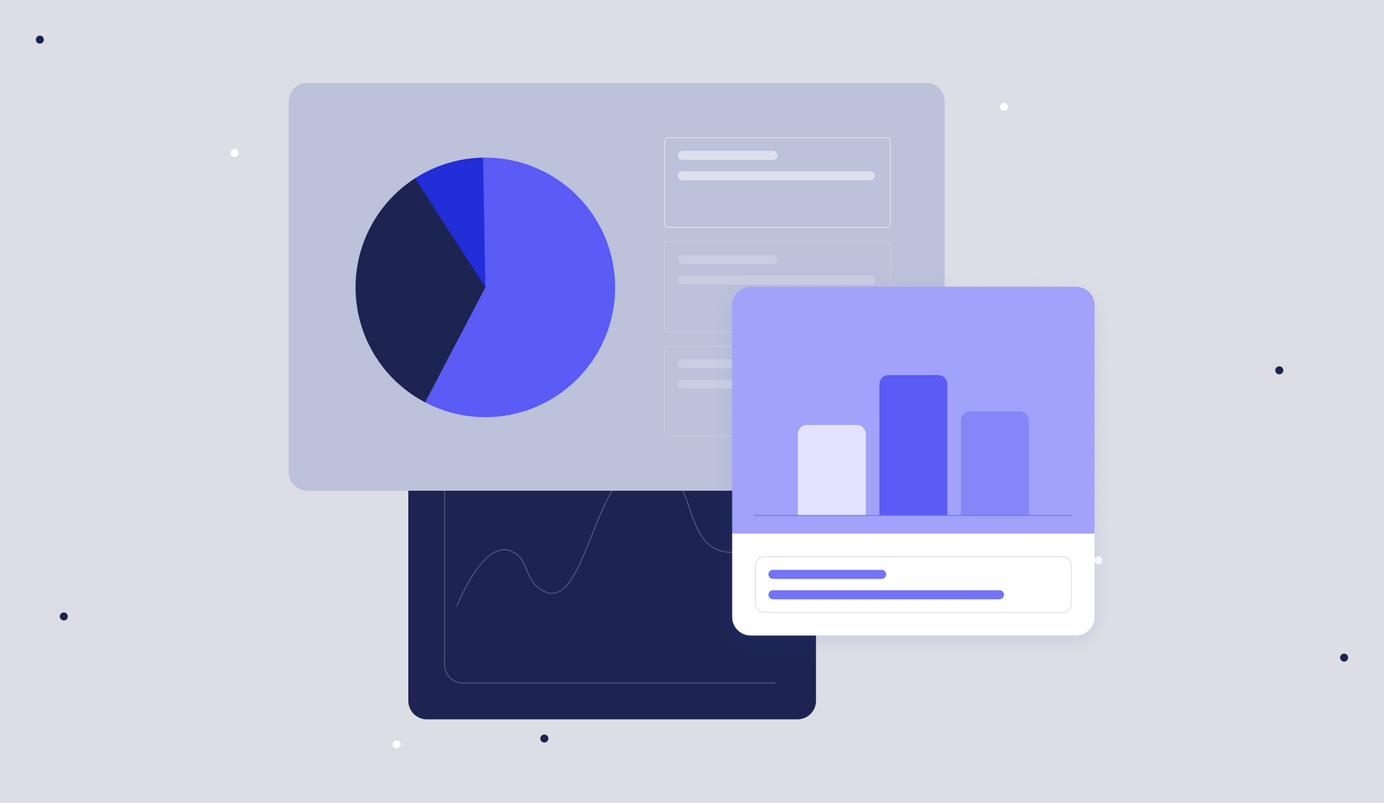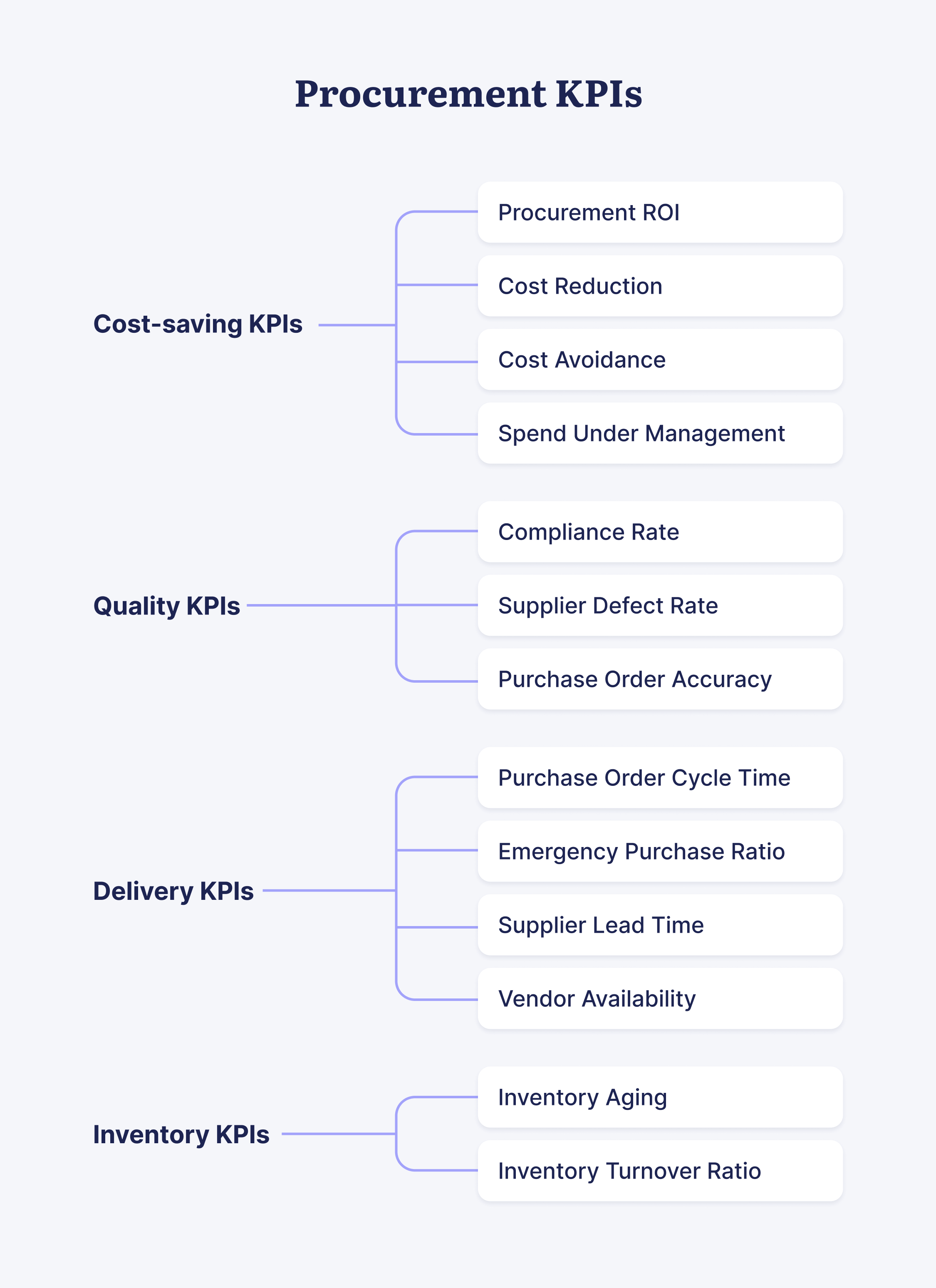
8 min read
Procurement KPIs & Metrics: What To Focus on and How To Measure
Check out our list of the top 13 procurement KPIs, learn how to track them, and what to focus on to drive the most value to your company.
The old saying "If you cannot measure it, you cannot improve it" holds as true as ever.
In today's competitive market, where it's not all about cost savings, tracking procurement performance and aligning it with business goals and objectives is a must-have.
So how do you measure the effectiveness of procurement operations within your organization?
The answer is simple: through KPIs.
Keep reading to learn in detail about the top 13 most crucial procurement metrics, how to track them, and what to focus on to drive the most value to your company.
- What Are Procurement KPIs, and Why Use Them?
- Procurement KPI Categories
- Cost-saving KPIs
- Quality KPIs
- Delivery KPIs
- Inventory KPIs
- What to Focus On
- Boost Your Procurement Performance With Easy-to-Use Software
What Are Procurement KPIs, and Why Use Them?
Procurement key performance indicators (KPIs) are values that measure the performance of an organization's procurement management based on specific business goals and objectives.
Procurement metrics monitor everyday operations to help organizations identify improvement areas, their competitiveness on the market, where they can save money, and whether they are growing or declining as a business.
By choosing the right KPIs and with the help of manageable and actionable metrics, one can significantly improve decision-making and have a clear picture of current performance levels.
In addition to the benefits mentioned above, here are some more reasons why you need procurement KPIs:
- Reduce supply risks and prevent maverick spending.
- Enable procurement managers to improve data-driven processes.
- Optimize organizational spending, time, and sourcing of goods or services.
- Align procurement workflow with business objectives, goals, and strategies.
Procurement KPI Categories
Depending on their purpose, procurement KPIs can be divided into the following categories:

- Cost-saving KPIs: Procurement ROI, Cost Reduction, Cost Avoidance, Spend Under Management (SUM).
- Quality KPIs: Compliance Rate, Supplier Defect Rate, Purchase Order Accuracy.
- Delivery KPIs: Purchase Order Cycle Time, Emergency Purchase Ratio, Supplier Lead Time, Vendor Availability.
- Inventory KPIs: Inventory Aging, Inventory Turnover Ratio.
Each category is a crucial element of an efficient procurement process and no single one should be forgotten.
To ensure all the benefits that procurement management can offer, you need to implement a comprehensive approach, focusing on the most overlooked KPIs in your company.
Cost-saving KPIs
Procurement ROI
Procurement ROI is used to determine the overall profitability and cost-saving benefits of a procurement function or investment.
It’s important to keep in mind that procurement ROI measures only the hard savings and does not consider cost avoidance.
Therefore, it works best when correlated with other KPIs to get a complete picture of your team's performance.
How to measure: Calculate the ratio of your annual cost savings to your internal yearly costs of procurement.
Cost Reduction
This procurement KPI helps measure the tangible hard savings achieved over a certain period using cost management practices.
Cost reduction tells you how competent your procurement team is at driving savings and how effective your cost management techniques are.
It also helps the procurement department optimize the supplier lifecycle and increase efficiency by implementing supply chain analytics.
How to measure: Compare the old costs with the new costs for the same good or service. Then break them down into different supplier categories and track the ones with the highest savings.
Cost Avoidance
This metric helps the procurement department reduce future costs and prevent price increases due to inflation or other economic factors.
It measures the effectiveness of the preventive actions undertaken by procurement teams, including sourcing better supplies and equipment, replacing faulty equipment, and investing in process improvement.
Unlike cost reduction, cost avoidance targets strategic spend or soft savings that don’t explicitly appear in the company's bottom line.
This is why it works best when paired with cost reduction, which is known for tracking hard savings.
How to measure: Subtract the awarded bid total amount from the average.
Spend Under Management
Spend under management or SUM is the percentage of procurement spending controlled by the management department.
The higher percentage of these strategically managed costs, the more potential for cost-optimization arises.
While completely eliminating maverick spend is quite unrealistic, your task is to determine whether its presence in your processes is as minimal as possible.
How to measure: Calculate the difference between the total approved spend (direct, indirect, and service-related costs) and maverick spend.
Quality KPIs
Compliance Rate
Measuring compliance rate helps companies understand whether the supplier meets business requirements.
It includes aligning with contractual and policy compliance, such as delivery time, the price paid for goods, maximum reaction time in case of delays, payment mode, etc.
If this KPI rate drops, it may result in a high risk of increasing indirect or maverick spending and thus hurt your bottom line.
How to measure: Compliance rate can be measured by calculating:
- The ratio of disputed to total invoices.
- The difference between the paid and quoted prices.
- Accuracy in terms of the quantity of goods delivered.
Supplier Defect Rate
This KPI is used to evaluate the quality of each supplier by measuring the total number of substandard products to the total number of units inspected.
The procurement department can calculate the supplier defect rate based on defect types and generate valuable insights into supplier performance and reliability.
This is especially important for industries like automotive and aerospace, where the stakes are high and multi-tiered supplier bases are maintained.
How to measure: Divide the total number of defective products by the total number of units tested.
Purchase Order Accuracy
This metric is used to assess whether the suppliers deliver the correct goods at the right time according to the purchase orders.
A low purchase order accuracy may increase the company's operating costs. That's why it's critical to ensure that the ratio of product/service delivered outside of the predefined service target remains low.
How to measure: Extract the percentage of purchase orders with line item, pricing, quantity, or delivery date/address errors from the total number of purchase orders over a certain period.
Delivery KPIs
Purchase Order Cycle Time
This KPI shows the total time spent on a purchase order throughout the procurement process, from its creation to payment completion.
It excludes goods' production and delivery time and is measured in hours or days.
Purchase order cycle time is extremely valuable when it comes to identifying the right supplier to respond to urgent orders and fulfilling them quickly.
How to measure: Calculate the total time spent on purchase orders and categorize your suppliers by cycle time:
- less than 4 days - short cycle time;
- from 4 to 8 days - medium cycle time;
- more than 8 - long cycle time.
Emergency Purchase Ratio
While emergency purchases are sometimes a necessary last resort due to unexpected product shortages, a high rate of ad hoc orders can easily result in high procurement costs, lost discounts, and maverick spending.
It's also a sign of poor procurement planning and a lack of business efficiency.
Tracking emergency purchases will help you save money, improve procurement strategies, reduce supply risk, and ensure the continuity of goods.
How to measure: Calculate the ratio of your organization's emergency purchases to the total number of purchases made over a fixed period.
Supplier Lead Time
This KPI reveals how long it typically takes a supplier to ship an order after receiving it.
It's typically measured in days, starting with the availability confirmation and ending with the delivery.
If particular suppliers consistently fall short of projected lead times, action may be needed, as this can start to affect your own company’s ability to meet demand.
How to measure: Subtract the PO acceptance time from the delivery time (goods and receipts delivery).
Vendor Availability
As stated earlier, a high ratio of emergency purchases isn't a good sign for your business.
Still, it's great to know that you have vendors that can respond to emergency demands if needed.
When measuring supplier availability, you always know whom you can rely on in case of a critical situation.
How to measure: Calculate the ratio of the number of times items were available with the vendor to the total number of orders placed.
Inventory KPIs
Inventory Aging
An inventory aging report provides key metrics on how quickly your inventory moves.
It contains a list of all available items that are grouped based on their time spent in inventory.
This KPI is used to determine which inventory is slow-moving or obsolete and the costs associated with storing and maintaining these items.
A good inventory age is usually 60 to 90 days from the date of receipt. Inventory over 180 days is generally considered dead stock and should be prioritized before ordering new products.
How to measure: To find inventory age, follow the formula: average inventory age = [average inventory cost ÷ cost of goods sold] x 365.
Inventory Turnover Ratio
This metric shows how often a company has sold and replaced inventory during a given period.
It helps businesses measure the effectiveness of inventory management and make better decisions on pricing, manufacturing, and purchasing.
A low inventory turnover ratio may indicate weak sales or excess inventory, while a higher ratio indicates strong sales but may also mean inadequate inventory stocking.
How to measure: Divide the inventory days by 365 and flip it. For example, if inventory has been in stock for 55 days, then the formula will be the following = 1 / (55/365) = 6.6. This means you can sell and replace the stock of goods about 6 to 7 times a year.
What to Focus On
As you can see, there are many procurement key performance indicators to choose from, and tracking them all at once may not be a good option, as it can easily lead to confusion, poor measurement, and extra work.
It's better to narrow down the list to only those KPIs that are most critical for you at the moment, and that will help drive your strategy and improve poorly optimized processes.
Let's discover how to select the most relevant procurement KPIs for your business.
Prioritize
Choose one or a couple of metrics that will directly contribute to each of your procurement goals.
Take into consideration how hard it may be to track specific KPIs and how many individuals you have available for this task, as it will also contribute to the final results.
Check if a given KPI meets your requirements:
- Is it easy to measure the KPI promptly and accurately?
- Does this KPI align with the overall company objective and strategy?
- Does the KPI cover a wide array of procurement perspectives?
- Do we have enough people to measure it properly?
- Will the KPI have the potential to help us solve the current procurement challenges?
If most of these questions are a “yes,” the KPI is one to track.
Allocate KPI Responsibilities
KPIs serve as valuable tools for measuring progress. Still, they are most likely to produce results and drive value if there are responsible teams dedicated to tracking and reporting them.
Allocate the KPI responsibilities to concerned teams and individuals and give them appropriate deadlines to collect information and prepare reports.
Make It Systematic
Don't forget to check your KPIs regularly, e.g., monthly, quarterly, or by other predefined reporting frequencies.
Regular monitoring helps identify when your business is under-or-over-performing and what might have happened during that period to cause a change.
Share your findings with relevant parties regularly, since many goals in an organization are interconnected. This ensures everyone is on the same page.
Boost Your Procurement Performance With Easy-to-Use Software
Key performance indicators are valuable tools when it comes to measuring the performance of your procurement team and identifying areas where savings can be achieved.
Still, without proper technology in place, it can be quite challenging to keep track of these metrics, collect data, and drive improvements.
Let's see how a procurement solution can help:
- Have all the necessary data easily accessible anytime and anywhere.
- Streamline requests, purchase orders, invoices, and vendor management.
- Track all procurement KPIs from a centralized dashboard effortlessly.
- Eliminate redundant and repetitive tasks thanks to process automation.
- Lessen HR’s workload by reducing the need to hire and train more staff.
- Sync documents, vendors, and all the information you need within accounting or ERP systems.
These are just a few benefits more than 1000+ Precoro users enjoy daily.
Want to experience them yourself? Book a demo to have a personalized product overview and get all your questions answered.
Conclusion
Procurement KPIs are metrics that track and evaluate the efficiency of procurement processes within an organization.
They help businesses gain actionable insights into both internal and external operations and better align procurement strategy with company objectives.
You can track many key performance indicators, but it is crucial to set priorities correctly in order to see the best results.
Procurement leaders should take the time to define their business requirements and select KPIs that meet them, as well as implement the proper technology to mitigate risks and increase profitability.









